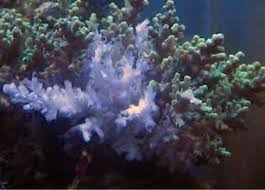While pests like flatworms and nudibranchs often get the spotlight, bacterial infections are an equally serious threat in reef tanks—especially for SPS and LPS corals. These infections can strike fast, spreading across colonies and even wiping out entire sections of your reef if not caught in time.
What Causes Bacterial Infections in Corals?
Bacterial infections are usually opportunistic. Stressful conditions weaken coral defenses, allowing harmful bacteria to invade. Common triggers include:
- Tissue damage from fragging or pest stings
- Fluctuating parameters (alk, salinity, temperature)
- Overhandling or poor acclimation
- Introduction of infected corals without proper dipping or quarantine
Pathogenic bacteria may be introduced via livestock, tools, or contaminated water.
Common Types of Coral Bacterial Infections:
1. RTN (Rapid Tissue Necrosis):
- Tissue peels off very quickly, sometimes hours
- Most common in Acropora and other SPS
- Often starts at the base or tip
2. STN (Slow Tissue Necrosis):
- Similar to RTN but progresses over days or weeks
- Subtle and easy to miss early on
3. Brown Jelly Disease:
- Affects LPS corals
- Brown, slimy substance forms on infected area
- Very contagious and deadly if untreated
Symptoms to Watch For:
- Sudden or spreading tissue loss
- Brown, stringy or cloudy mucus
- Foul smell from affected corals
- Coral flesh receding from skeleton
- Polyps retracted for extended periods
How to Treat Bacterial Infections:
1. Frag and Remove Infected Tissue
- Use bone cutters to trim several millimeters above the necrotic zone
- Dip the healthy frag in iodine or antiseptic solution (e.g., Lugol’s, Coral RX, Revive)
- Discard infected tissue safely
2. Antibacterial Dips
- Iodine dips (strong concentration for 5–10 minutes)
- Commercial dips (Revive, Bayer*) can reduce bacterial load
- Brown Jelly can sometimes be treated with hydrogen peroxide dips (with extreme caution)
Note: Bayer is not reef-safe and should only be used in separate dip containers.
3. Stabilize Parameters
- Eliminate sudden changes in alkalinity, salinity, and temperature
- Improve flow and oxygenation
4. Improve Water Quality
- Run activated carbon to remove organics
- Perform small water changes
- Reduce feeding if nutrients are elevated
Should You Use Antibiotics?
In severe cases, reef-safe antibiotics (like those from Fauna Marin or Red Sea) can be used in coral quarantine tanks. Avoid dosing your display unless absolutely necessary and you know what you’re treating.
Prevention:
- Dip and quarantine all incoming corals
- Avoid fragging stressed or new arrivals
- Maintain stable parameters
- Keep tools clean and separate for fragging vs. display
Final Thoughts:
Bacterial infections are silent killers that often strike when corals are already vulnerable. Fast response is critical. Frag infected areas, dip aggressively, and stabilize your tank. When in doubt—quarantine, observe, and don’t take risks with the rest of your reef.
